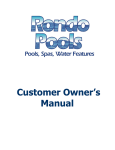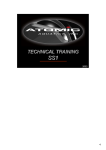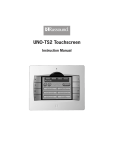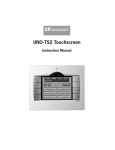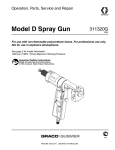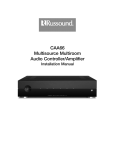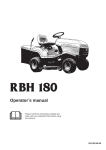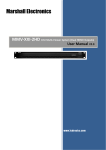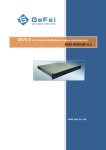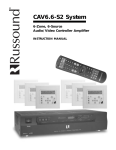Download Atomic Aquatics Safe Second Inflator User manual
Transcript
FIRST AND SECOND STAGE REGULATORS TECHNICAL SERVICE PROCEDURES Note: These instructions and schematics are intended for use by qualified regulator repair technicians. They are intended to supplement, not replace service clinics provided by Atomic Aquatics to authorized Atomic Aquatics dealers. How to use this guide: Use these notes in conjunction with the schematic drawings. These notes provide additional details about the specific procedures and are common to all Atomic models. Tools: See the schematic section for a complete list of recommended tools. Special multi- function tools are available for the 1st or 2nd stage Atomic Aquatics Regulators. Contact : Peter Built at (419) 468-2212 or the factory for ordering information. Lubricants: Lubricants: For lubrication, only Christolube™ MGC 129 or MGC 111 may be used. Lightly lubricate all threads and o-rings, unless otherwise noted. Christolube is a trademark of Lubrication Technologies Inc., Jackson, OH, phone: (614) 286-2644. ! Enriched Air (Nitrox) Compatibility: WARNING: These regulators may be used with Enriched Air Nitrox (EAN) only when used within the following specific limits and guidelines. Atomic Aquatics first and second stage regulators, (T1x, T1, B1, B2, Z1) are supplied factory cleaned and ready to use without modification with EAN mixtures no greater than 40% oxygen concentration at pressures no greater than 3500 psi. This is provided that the regulator is dedicated for such use at point of sale and not contaminated by pressurizing with an air source that is not hydrocarbon free and oxygen compatible. The SS1 Safe Second/Inflator may be used without modification with EAN mixes up to 50% oxygen concentration. The M1 has been specially designed to handle high EAN mixes. The M1 may be also used interchangeably with air or EAN mixes of up to 50% oxygen concentration at 3500 psi maximum. The M1 may be used with up to 80% oxygen concentration at a maximum pressure of 3000 psi, provided it is dedicated for this service and kept in an O2 clean condition. Atomic Aquatics recognizes and recommends the guidelines developed by of the ANDI (American Nitrox Divers International) for proper handling of Enriched Air Nitrox equipment. REGULATORS MAY ONLY BE USED WITHIN THESE SPECIFIC LIMITS AND GUIDELINES 1. Never pressurize these regulators with pure oxygen. 2. For T1x, T1, B1, B2, & Z1 models. The oxygen concentration of the mixture must be no greater than 40% and at pressures no greater than 3500 psi. These models must be dedicated for EAN use and not contaminated by use with compressed air that does not meet the ANDI oxygen compatible gas purity standard. The M1 regulator may be also used interchangeably with air or EAN mixes of up to 50% oxygen concentration at 3500 psi maximum. The M1 may be used with up to 80% oxygen concentration at a maximum pressure of 3000 psi, provided it is dedicated for this service and kept in an O2 clean condition. The SS1 Safe Second/Inflator may be used without modification with EAN mixes up to 50% oxygen concentration. ATOMIC AQUATICS FIRST AND SECOND STAGE REGULATORS MAINTENANCE PROCEDURES • 9/2003 1 3. EAN mixtures must meet minimum ANDI purity standards for oxygen compatible air. 4. Equipment must be dedicated for EAN use and not contaminated by use with compressed air that does not meet the ANDI oxygen compatible gas purity standard. 5. Equipment that has been contaminated must be re-cleaned before use with EAN. 6. Cleaning of parts must be done with Blue Gold™ or an ANDI approved cleaning solution. 7. During regulator servicing, only Atomic Aquatics factory supplied o-rings and spare parts may be used. 8. For lubrication, only Christo-lube™ MCG 111 or MCG 129 must be used. Do not use silicone grease in or around EAN equipment. ! WARNING Failure to comply with the above guidelines could result in the increased risk of ignition or fire that could result in personal injury or death. GENERAL Major service which includes disassembly, cleaning, and replacement of all seats and seals is recommended either annually (Z1) or every 2 years or 300 dives (T1x, T1, M1, B1, B2, SS1), whichever comes first. This extended service period is due in part to the extreme corrosion resistance of the titanium components and the unique, maintenance saving designs. We do require that the owner performs preventive maintenance (fresh water rinsing) as outlined in the user manual. The owner should also bring the regulator to the dealer for an annual safety inspection to check for proper functioning and advise the customer of any problems that might necessitate an earlier than scheduled servicing. Otherwise, repair or service should be done according to the 2 year or 300 dive schedule. Major service kits containing all necessary service parts (o-rings, filters and seats) are available for 1st and 2nd stages at a nominal charge. These items are not supplied free of charge under warranty unless found to be defective from the factory . CLEANING In the case of the second stage and the all titanium first stages, acids or harsh chemical cleaning agents are not needed nor recommended. Pre-clean all parts to remove major contaminants. Ultrasonic cleaning with an approved cleaner or hot soapy water is the preferred cleaning method. Corrosion products on brass parts can be removed by further cleaning in a 50% white vinegar/water solution or commercial scuba parts cleaner such as DT-2001*. Do not use muriatic or hydrochloric acid solutions as they will destroy chrome finishes and may attack certain types of stainless steels. SPECIAL CLEANING FOR NITROX USE We recommend cleaning with a hot solution of Blue Gold*, preferably in an ultrasonic cleaner. Dilution ratio is 1:20 Blue Gold to clean water. The optimum cleaning temperature is 140°F (60°C). Rinse thoroughly with clean water, then air dry. Parts should be cleaned until there is no trace of hydrocarbon residue. Reassemble parts is a clean work area, with clean or gloved hands and minimize handling of internal components to reduce contamination. Lubricate with Christo-Lube111 or 129 only. Special note: Simple Green Cleaner™. Although a popular cleaner, we do not recommend the use of Simple Green™ for Nitrox cleaning because it will break down if heated above 130°F and may leave questionable residues. *References: See for further information on Nitrox Cleaning 1998 Directory of Cleaning agents for oxygen service. Compressed Gas Association, Inc. (703) 412-0900 CGA G-4.1 Cleaning equipment for oxygen service. ASTM G-127-95 Standard Guide for the Selection of Cleaning Agents for Oxygen Service. DT-2001 Cleaner manufactured by Diving Technologies Int. (954) 748-4772 Blue Gold Cleaner distributed by MetalLube Corp., Riverside CA (909) 279-9181 ATOMIC AQUATICS FIRST AND SECOND STAGE REGULATORS MAINTENANCE PROCEDURES • 9/2003 2 ANNUAL FUNCTION TEST 1. 2. 3. 4. 5. 6. 7. 8. Breathing effort Vacuum leak test Adjustment knob Air leak test AFC Intermediate pressure Filter General Inspection Regulators: 1.1"-1.4" SS1: 1.2"-1.8" No leaks allowable upon inhalation when inlet blocked (air off) Should turn freely, increase effort approximately 1" at full adjustment No air leaks allowable when pressurized, first or second stage. Check for free movement, should return when retracted manually and released 125-145 psi Check for excessive dirt, corrosion Check for signs of damage, tightness of all hoses, plugs, and threaded connections. TROUBLESHOOTING GUIDE (2ND STAGE) Symptom Suggested Service 1. Leaks air 2. Water leakage 3. Hard breathing 4. AFC plunger inoperable 5. Adjustment knob hard to turn 6. Uncontrolled free-flow First stage pressure too high, check and reset to 125-145 psi Readjust lever and poppet spring tension to 1.1-1.4" Clean sand/debris from demand valve Replace poppet seat Check mouthpiece/diaphragm/exhaust valve for tears Check tightness/fit of diaphragm retainer Check case o-rings for dirt, cuts Readjust lever and poppet spring tension Lubricate poppet o-ring Check/clean sand or debris in plunger Check for leaks at AFC cover/replace diaphragm if torn Lubricate knob stem o-ring Check mouthpiece type. Non-factory mouthpieces may cause this. Cracking effort set too low. AFC Plunger stuck in max. depth position. TROUBLESHOOTING GUIDE (1ST STAGE) Symptom Suggested Service 1. High or low I.P. 2. Intermediate pressure creep 3. Air leaks out of ambient ports Lubricate piston seals and shim as needed Replace seat, check piston sharp edge for damage Dirty or damaged HP piston seal or o-ring. Remove, clean body and seal, reassemble. ASSEMBLY/ADJUSTMENT NOTES (2ND STAGE) REFER TO SCHEMATIC 1. Front cover and diaphragm-removal/replacement (T1x, T1, B1, B2, Z1) • • • Unscrew the cover ring surrounding the front cover. Unscrew the diaphragm retaining ring with the front cover, or the 2nd stage rim clamp tool. Lift out the thrust washer and diaphragm. ATOMIC AQUATICS FIRST AND SECOND STAGE REGULATORS MAINTENANCE PROCEDURES • 9/2003 3 After removing the front cover ring, leave the front cover in place, and push it tight into your palm to unscrew it. If the front cover is tight, place the 2nd stage rim clamp tool around the front cover, which will allow you to apply extra leverage to loosen the front, cover ring. The front cover will unscrew the diaphragm retaining ring, if you are encountering troubles loosing the retaining ring use the 2nd stage rim clamp tool by engaging the pins into the slots of the diaphragm retaining ring. Lift out the thrust washer and diaphragm. Assembly is the reverse, replace the diaphragm edge carefully into the groove in the case. Replace the thrust washer on top of the diaphragm. Install the front cover into the groove of the diaphragm retaining ring. Use the palm of your hand to tighten the cover and ring together snugly into the case. Remove the cover from the retaining ring and reinstall it so the logo is straight. Screw on the outer front cover ring hand tight, then turn the front cover until straight and tighten the front cover ring down completely. Front cover and diaphragm-removal/replacement (M1) • • • Unscrew the front cover and cover ring as one assembly. Unscrew the diaphragm retaining ring with the 2nd stage rim clamp tool. Lift out the thrust washer and diaphragm. If the cover ring cannot be removed by hand, use the 2nd stage rim clamp tool. After removing the front cover, Unscrew the diaphragm retaining ring by engaging the pins into the slots of the diaphragm retaining ring with the 2nd stage rim clamp tool. Lift out the thrust washer and diaphragm. Assembly is the reverse, replace the diaphragm edge carefully into the groove in the case. Replace the thrust washer on top of the diaphragm. Install the diaphragm retaining ring and tighten with the 2nd stage rim clamp tool. Screw on the outer front cover and ring hand tight, then turn the front cover until straight. 2. Rear exhaust cover and exhaust valve-removal/replacement The silicone rubber exhaust valve and rear exhaust cover should never need replacement, and it is not normally necessary to remove these components. • • • Locate the two slots in the bottom front of the case where the case and rear cover meet. Use a flat bladed screwdriver that is close to the same width as the recess and pry the cover up slowly (do not twist the screwdriver) to unhook the snap. Repeat with the other side then pull the cover off. To reassemble, engage the top 2 tabs of the cover and snap the bottom of the cover over the case. 3. Automatic flow control (AFC) check/disassembly • To check, manually push the plunger back and forth into the case and check to see if it returns when released. The AFC will operate as long as the AFC diaphragm does not leak, and it generally does not need to be serviced. It can be tested by checking its position at the surface and when pressurized in water during actual use, or in a test chamber. It should be fully extended across the mouthpiece at the surface, and fully retracted at about 60 feet. • • • To disassemble, remove the AFC cover with a spanner (2nd stage T-handle tool). Withdraw the diaphragm and plunger as an assembly. Clean off the parts, check the diaphragm for tears and reassemble. If the diaphragm is replaced, pull the stem of the diaphragm through the hole in the blade and cut off the excess stem leaving about 1/8" exposed. 4. Inlet tube: removal from case • • • Remove the hose, front cover, diaphragm and jam nut. There is no jam nut used with atomic comfort swivel hoses. Push the inlet tube out towards the knob end until the splines on the knob sleeve are clear of the case. Unscrew the knob assembly completely off the inlet tube. ATOMIC AQUATICS FIRST AND SECOND STAGE REGULATORS MAINTENANCE PROCEDURES • 9/2003 4 • Depress the lever and withdraw the tube from the case. The balance chamber, spring and poppet will slide out of the knob side of the inlet tube. It is necessary to slightly open up the lever legs just a bit to allow the poppet to drop free. The orifice and wave washer can be removed by pushing wooden pencil (point end first) into the orifice from the hose end and withdrawing them with the pencil. Don’t use hard metal tools or you may damage the orifice edge. The orifice adjustment sleeve is not normally removed but can be by leaving the orifice in place and using it to unscrew the sleeve until it is clear of the threads. Then you can push the sleeve out with a pencil (eraser first) from the knob end. The o-ring on the sleeve is not a pressure seal but to provide a friction fit. 5. Lever and lever sleeve, removal/replacement • • Lever: spread one leg of the lever just enough to clear it from one side of the sleeve, then the other side. Don’t overspread the lever legs more than needed or you may permanently deform it. The lever sleeve provides a low friction bearing surface for the lever and will last many thousands of cycles. It should not be removed or replaced unless damaged or obvious wear is apparent. Do not attempt to reuse it once removed. • • Lever sleeve: spread apart the sleeve at the open end and slip it off the tube. Lever sleeve-replacement: align the small tip on the inside of the collar with the small hole in the inlet tube. The open sides of the square hole face towards the knob. Spread the sleeve enough to push it into over the tube next to the groove it fits in. Once over the tube, slide it into the groove and make sure it snaps fully into position. The lever sleeve provides a low friction bearing surface for the lever and will last many thousands of cycles. It should not be removed or replaced unless damaged or obvious wear is apparent. Do not attempt to reuse it once removed. 6. Poppet/seat replacement • Grasp the silicone rubber seat and pull it out of the plastic poppet. To replace, do not use any lubricant on the new seat, just push it in completely with a slight twisting motion until it is completely seated into the head of the poppet. There should be no gaps between the head of the poppet and the poppet seat. 7. Replacing the poppet into the inlet tube • • Install the lever first. Generously lubricate the poppet o-ring, and insert it with the poppet into the second stage T-handle tool. Align the flat side of the poppet with the flat on top of the inlet tube (lever up). Pivot the lever all the way up and over center to the highest position, then carefully push the poppet into the inlet tube until the poppet seat passes the legs of the lever and it snaps into place. The small tabs on the ends of the lever legs are notched at a 45 degree angle so when the lever is lifted, the poppet will slide easily into place. Withdraw the tool. If no tool is available, insert the poppet by hand, and take care to keep it aligned during assembly. There is only one way the poppet will fit correctly. If the poppet rotates during assembly it will not engage the lever. Withdraw it and try again. Do not force the parts. After the lever is in place, insert the spring and the balance chamber. Push gently on the balance chamber with your finger and test the lever to make sure it moves the poppet. Lubricate the poppet o-ring generously. 8. Knob components • • • • • Remove the knob assembly from the inlet tube and case (see #4) Using a 1/8" hex wrench, remove the knob retainer in the end of the knob. Screw the knob stem clockwise all the way into the adjustment sleeve. Slide the knob off of the stem and push it out of the adjustment sleeve. Unscrew the spring pad out of the stem with a 1/8" hex wrench. ATOMIC AQUATICS FIRST AND SECOND STAGE REGULATORS MAINTENANCE PROCEDURES • 9/2003 5 The knob subassembly is o-ring sealed from water and debris. There is one dynamic o-ring in the knob stem that can be lubricated if the knob becomes stiff to operate. This o-ring and the plastic split washer next to it can be removed for cleaning and lubrication. To reassemble, screw the spring adjustment pad fully back into the knob stem, and the stem fully into the adjustment sleeve. Replace the knob and knob retainer. 9. Final demand valve assembly • • • • • • Assemble the orifice, washer and orifice sleeve (if removed) together. Screw them fully into the housing, then back out about 3/4 turn, or use the slotted end of the second stage T-handle tool. The special tool limits the depth the orifice can be installed to the preliminary setting. Replace lever and poppet. (see #5-6) make sure they are installed correctly. Insert the inlet tube into the case. Rotate it to engage the square on the tube into the square on the case. Install the spring and balance chamber. Thread the knob assembly onto the inlet tube. You will have to pull the tube out slightly from the case to thread onto knob on completely. Thread it on until it stops, then check the alignment of the ribs on the sleeve with the grooves in the case. If they do not align, unscrew the knob sleeve just enough to align the ribs and push the tube fully into the case. • Replace and torque the jam nut and hose. If the comfort swivel is installed, the jam nut is not used. Assemble the o-ring onto the inlet and re-fit the swivel hose assembly. 10. Second stage adjustment - Use a second stage pneumatic adjusting tool if available. • • • Initial adjustment as follows: The orifice is screwed fully into the tube then out 3/4 turn, the adjustment knob all the way out, and the spring pad fully retracted into knob (counterclockwise when looking at knob end. Pressurize and unscrew the orifice away from the seat until the lever reaches its highest possible position and does not leak. Operate the lever several times, then screw the orifice back in so a very small amount of lever travel is allowed (1/32") before the poppet leaks. Operate the lever again and test for leaks. Screw the spring adjusting pad in or out with a 1/8" hex wrench until a cracking effort of approximately 1.1-1.4" is achieved. Avoid setting the cracking effort it lower than 1.1" because the regulator may leak air if placed in water in the head down position. If a gauge is not available, the cracking effort can be set by water testing. Cover and seal the mouthpiece tightly with your finger and set the second stage underwater, with the exhaust valve up. Screw the spring pad in or out to set the cracking effort until air no longer escapes out the exhaust valve. Gently purge and retest. Note: Screwing the knob all the way in should increase the effort about 1" above the 1.1-1.4" setting. ASSEMBLY/ADJUSTMENT NOTES (1ST STAGE) REFER TO SCHEMATIC 11. Swivel and cap (T1x, T1, M1, B1, B2) Loosening • • Mount first stage on a valve on an empty tank or workbench. Loosen with the pin-lock first stage spanner (Peter Built p/n 24-160-140). Align the hole in the tool with the indentations on the swivel cap. Engage the nylon hex screws into the indentations and unscrew to loosen from the body. A conventional pin type first stage spanner may be used if a pin-lock tool is not available. If using a conventional spanner, take special care not to slip the tool or it will scratch the chrome or the titanium. Check your tool for proper fit and make sure the pins are not worn or rounded Fixed cap (Z1) • Install the 3/8-24 threaded end of the first stage handle (noted above) into a side port of the Z1 cap. Unscrew the cap to loosen. ATOMIC AQUATICS FIRST AND SECOND STAGE REGULATORS MAINTENANCE PROCEDURES • 9/2003 6 12. Yoke: removal/replacement • • • • Leave low pressure port cap on the regulator body (loosened) so the first stage can be held in a vice or clamp Unscrew the yoke knob from yoke. Unscrew the yoke nut with the special 1" yoke nut socket and short extension placed through yoke. Reassemble with same tool and torque to 33 FT.-LBS. The filter can be replaced by removing the star shaped filter retainer. Replace with a new filter and retainer. The o-ring in the bottom of the yoke retainer does not need lubrication. Fit the o-ring into the groove and make sure it stays in place during reassembly. The first stage can be switched between yoke or 300 Bar DIN by interchanging either the yoke retainer and yoke or the DIN retainer and handwheel. 13. DIN: removal/replacement • • Unscrew the DIN nipple with a 1/4" hex wrench from the body. Reassemble with same tool and torque to 33 FT.-LBS. Beneath the o-ring at the bottom of the nipple is a small washer and the filter. Make sure all these parts are in place during reassembly. The o-ring does not require lubrication. 14. Swivel and cap (T1x, T1, M1, B1, B2): removal/replacement • Unscrew the cap and swivel from the body. • Unscrew the swivel retainer from the swivel cap with a 7/32 hex wrench. • Reassemble and torque to 130 IN.-LBS. Use a first stage handle (Peter Built p/n 20-115-100 or 20-116-100) to hold the cap from turning. The swivel o-rings should be lubricated generously with Christolube. Make sure the small plastic washer is fit in place. • Reassemble the cap and swivel subassembly to the body. Securely tighten the swivel cap with the pin-lock spanner. Fixed cap (Z1) • Unscrew the cap from the body. To reinstall, thread the end of the pin lock first stage spanner into one of the LP ports and tighten securely. 15. HP seat (refer to Service Bulletin #2 for correct seat and piston configurations) • • • Unscrew the seat retainer with the first stage T-handle wrench. Blow air into the small hole in the back of the retainer to remove the seat. Replace with new seat (concave side out) and re-torque firmly. There are 2 o-rings that seal the seat, one in the body and the second on the seat retainer. Lubricate with Christolube sparingly. Make sure the o-ring in the body is seated in the groove before reassembly. 16. HP piston o-ring removal/replacement • • • • Remove the piston and spring by pulling it out of body. Remove the seat retainer and small seal retaining spring. Use the piston bullet (o-ring side first) to push the monel washer, HP piston seal or o-ring and the teflon washer out of the body. Replace in reverse order, using the seal pusher tool on the first stage T-handle tool. The piston can be removed and replaced without damage to the o-ring provided a piston bullet is used and the following procedures are followed. The o-ring should not be removed unless it is going to be replaced. To remove the o-ring, withdraw the piston and first stage spring. Using the brass piston bullet, push it through the body from the piston end. The bullet will push out the teflon washer, HP piston o-ring, and seal retaining washer. To reinstall, clean and examine the piston seal bore carefully. It must be smooth and perfectly clean. Lubricate the bore with Christolube. Install the HP piston o-ring, then follow with the teflon washer. Lubricate both generously with Christolube and carefully push them into the body until you feel them snap into place, then withdraw the tool, leaving the o-ring and teflon washer in the body. Install the seal retaining washer and seal retaining spring. ATOMIC AQUATICS FIRST AND SECOND STAGE REGULATORS MAINTENANCE PROCEDURES • 9/2003 7 Inspect the first stage spring carefully for signs of damage, cracks or corrosion. Replace if there are signs of red rust or pitting type corrosion. Be sure to use at least one shim on each side of the spring during installation. 17. Piston reassembly • • • • • • Place the piston bullet completely into the piston and lubricate it generously with Christolube. Install the backup washer and HP piston o-ring as in the previous section. Install the seal retaining washer on top of the o-ring. Place the piston guide tool (1st stage T-handle) into the body until it sits on top of the seal retaining washer. Place the T-handle in a vice or hold it in place and install the piston, with spring and bullet though the body and o-ring, and into the T-handle Remove the piston guide tool (T-handle) from the body and the piston bullet. CAUTION: You must use a piston bullet to avoid damaging the piston o-ring when replacing the piston. The piston guide tool is needed because without it, the piston will cut or push the seals out of the body when it is installed. If no tool is available, set the piston with spring and bullet on the table, hold the body in your hands with your fingers holding the small seal retaining spring in place, and drop the body over the piston and push the piston through the body, seal and spring. Keep the spring in place with your fingertips to keep the seal from pushing out of the body. The HP piston o-ring should be replaced at major service intervals and anytime the piston is exchanged. It should not be assembled/disassembled repeatedly except as needed during initial intermediate pressure setup. 18. Environmental seal ! WARNING - COLD WATER USE The environmental seal with Christolube lubricant should be installed when the regulator is used in water temperatures below 50 degrees F to prevent first stage freezing. First stage freezing could result in malfunction of the regulator that could lead to serious injury or death. The seal can be used under normal conditions also to completely eliminate water entry into the first stage, thereby reducing the possibility of corrosion . This also reduces the contaminants that could enter the ambient ports, and permanently lubricates the piston and seals. CAUTION: Do not install the environmental seal without completely filling the ambient spring cavity with Christolube lubricant. Doing so could result in lowered intermediate pressures at depth and poor regulator performance. • • • • Remove the swivel cap and trim ring. Install the environmental seal on the body in place of the trim ring. Lift the piston slightly and with a syringe, fill the space between the spring, piston and ambient chamber completely with Christolube MGC 111. Reassemble and pressure cycle several times until a stable intermediate pressure is reached. Reposition environmental seal into groove and wipe off excess lubricant. 19. Final first stage adjustment • • • • • Start with 2-3 shims, one on either side of the spring. Test at 500 and 3000 psi. Intermediate pressures should be between 125-145 psi. Re-shim as needed. Water test for leaks Adding or removing 1 shim will affect the pressure about 4-5 psi. Pressure should be stable with little pressure creep out of the allowed range of 125-145 psi. Excessive creep indicates a damaged piston edge detail or damaged HP seat. ATOMIC AQUATICS FIRST AND SECOND STAGE REGULATORS MAINTENANCE PROCEDURES • 9/2003 8 SS1 SUPPLEMENT Part 1. BCD Adapter Installation Adapters: A set of adapters is available for the SS1 to fit it to a wide range of hose sizes. Assembly is straightforward. There is one o-ring (20-2114-00) common to each adapter that is included in the service kit. Select the proper sized adapter for the particular BCD hose you have. The adapter may fit slightly snug but never loose. Some manufacturers may have used different size hoses in different models. Check the integrity of the BCD hose before installation. Rubber can become cracked or split with age. Refit with a new hose from the manufacturer if it is damaged or deteriorated. Cable Dump: All adapters are supplied with a cable pull pin. Each pin is a specific length to fit the specific adapter. Make certain you use the correct pin. The correct pin should be approximately the same length as the diameter of the adapter and not protrude from it when installed. The adapters must be secured to the hose with at least one cable tie and preferably two if room allows. We recommend gluing in place for added security using neoprene (wetsuit) cement. Water test all connections for leaks. Fully inflate the BCD and test operation of the cable dump if installed. The cable dump should not leak when the BCD is fully inflated and should release air when pulled slightly. Standard 1.0" adapter assy. This is the most common size and used on most BCD’s. Fits most Scubapro™, SeaQuest™, Zeagle™, TUSA™, IDI™ , Deep Outdoors™ and others. This adapter is assembled with the adapter sleeve as an integral component. Medium Adapter. Fits 3/4" to 13/16 hoses. Fits most Mares™. Adapter sleeve must be installed before inserting into hose. Small Adapter. Fits 11/16" to 3/4 “ hoses. Fits smaller diameter Oceanic™ and US Divers™. Adapter sleeve must be installed before inserting into hose. Part 2. SS1 Disassembly 1. Serial Number location. The serial number is located beneath the rubber mouthpiece. Clip the plastic clamp and remove the mouthpiece to read the number. Note: The mouthpiece is specifically designed for the SS1. Using other mouthpieces can change the venturi characteristics and make the SS1 susceptible to free-flow or increased sensitivity in the water. 2. Removal of Front Cover and Diaphragm. Position the SS1 on a firm surface with a towel under it to protect it. Using a short, flat bladed screwdriver, insert the blade into one of the elongated slots in the plastic body. Push down firmly to unlock the tab of the cover retainer. Repeat to unlock all 4 tabs then withdraw the cover retainer, cover, inner ring and diaphragm. ATOMIC AQUATICS FIRST AND SECOND STAGE REGULATORS MAINTENANCE PROCEDURES • 9/2003 9 3. Removal of Inflator Stem. Unscrew the inflator cover using the Atomic 2nd Stage AFC removal tool. Using the short flat bladed screwdriver, unscrew the plastic seat retainer from the plastic body. Now depress the inflator button and unscrew the inflator stem from the button. Put the button and spring aside. Push the stem and rubber seal out of the plastic body. Using an o-ring pick, remove the plastic bushing and o-ring from the body. 4. Removal of Exhaust Valve Unscrew the plastic exhaust cover. Lift up the edges of the exhaust valve and unscrew the plastic exhaust valve spider. If it is too tight, use the open jaws of a pair of long nosed pliers placed in between the legs of the spider to unscrew it. Remove the thin rubber gasket. 5. Removal of Deflation Button Using the 7/16" nut driver, unscrew the nut holding the exhaust seal from the exhaust stem. The button, stem, spring, washer and o-ring are now free from the case. Leave the stem attached to the button. If the unscrewing the nut happens to unscrew the stem from the button instead, the result will be the same. 6. Removal of Valve Body from Case Pull back and remove the hard rubber dust protector from the nipple of the inlet. Using an o-ring pick, push the C-clip out of its groove and slide it off the nipple. Don’t spread it open or you will bend it. Push the valve body assembly out of the plastic body. 7. Disassembly of Valve Body Using a 1/2" open end wrench on the inlet and adjustable wrench on the valve housing, unscrew the inlet from the housing. Be careful not to slip the wrench and damage the wrench flats on the inlet. Remove the orifice and plastic orifice sleeve from the housing. 8. Disassembly of Valve Housing Place the open end of the housing on a flat surface. Hold it in place to keep the parts inside from flying out during the next step. Using the 1/4" nut driver, unscrew the locknut completely from the poppet. The poppet and spring will drop free of the housing. Save the washer and small plastic insert in the top pf the housing. The locknut is usually replaced with a new one in the service kit. Part 3. SS1 Assembly 9. Assembly of Inflator Stem. Replace and generously lubricate the o-ring in the plastic case. Follow it with the bushing and the rubber seal. Make sure the bushing and seal are seated properly into the case. Thread the seal retainer into the body until it touches the seal to keep it in place but don’t tighten it yet. Insert the stem through the retainer and push it through the assembly until the threads come through the top of the case. Place the spring under the inflator button and screw the stem into the button until it is snug. Now tighten the seal retainer until it is snug. Operate the button several times to make sure it works smoothly. 10. Assembly of Deflation Button Replace and generously lubricate the o-ring in the plastic case. Coat the top of the o-ring with lubricant and place the washer on top of it. Coat the stem with lubricant and place the spring onto the shaft (large end toward button). Install the shaft through the washer, o-ring and plastic case. Install the exhaust seal onto the shaft (small diameter first) and secure with the nut. Operate the button several times to insure it works smoothly. 11. Assembly of the Exhaust Valve. If you have replaced the exhaust valve with a new one, cut off the rubber tip near the base of the valve. Replace the gasket onto the exhaust valve spider. Hold the spider upright to keep the gasket in place and screw the spider with the exhaust valve into the case. Snug it hand tight. Make sure the spider is completely screwed in. Operate the deflation button to insure the exhaust seal seats on the spider when the button is fully depressed. Replace the exhaust cover and snug it hand tight. ATOMIC AQUATICS FIRST AND SECOND STAGE REGULATORS MAINTENANCE PROCEDURES • 9/2003 10 12. Assembly of Valve Housing Remove and replace the rubber seat in the poppet with a new one. Grasp the new rubber seat and push it completely into the poppet. The rubber seat should be completely flat and flush with the end of the poppet. DO NOT USE ANY LUBRICANT ON THE RUBBER SEAT. Place the spring over the poppet and insert it into housing. If it was removed, replace the plastic insert into the top of the housing. Screw the orifice sleeve into the housing (flat side first) with the 1/4" Allen wrench. Screw it completely into the housing (don’t force it) to compress the spring and allow you to install the lever, plastic washer and new locknut over the threads of the poppet. Initially tighten the locknut until it the threads of the poppet just show through. Note: The lever is installed so it leans away from the oval shaped aperture of the housing. 13. Assembly of Valve Body Replace and lubricate the orifice o-ring. Insert it into the orifice sleeve and make sure it is screwed completely into the housing. Screw the inlet nipple onto the housing completely and snug with a 2 wrenches. Don’t over tighten or you may damage the parts. 14. Assembly of Valve Body in Case Replace and lubricate the 2 inlet o-rings. Align the flats on the housing with the flats inside the plastic case and push it into place. Push it completely into the case until the nipple protrudes from the case the retaining c-clip can be pushed into its’ groove. 15. Regulator Adjustment Check the intermediate pressure of the first stage. It should be in the range of 120-145 psi, and maintain steady pressure. If it does not, service the first stage. The SS1 is an unbalanced regulator design and its final adjustment will be sensitive to intermediate pressure variations. The adjustment is similar to any unbalanced second stage. Once adjusted, decreasing intermediate pressure will cause the regulator to breathe hard, and increasing it will cause it to breathe easily and perhaps become overly sensitive. For optimal performance, adjust the SS1 using the first stage it will be used with. If this is not possible, adjust it to the high end of the intermediate pressure range, 140-145 psi to prevent it from being overly sensitive. The initial adjustment of the orifice is fully retracted. Insert a 3/16" hex wrench into the nipple and unscrew it (counterclockwise) until it stops. Remove the wrench and install the quick disconnect. Slowly pressurize the regulator. Check that the lever is loose and has plenty of free play. If the regulator leaks, remove the quick disconnect, insert the hex wrench and tighten the orifice (turn clockwise) in 1/4 increments and retest until it stops leaking. Adjust the lever locknut so there is about 1/16" free play before it opens the valve. Install the diaphragm and hold in place while testing the cracking effort with a magnehelic gauge. The gauge should read between 1.25 and 1.5" with a light breath. Readjust the orifice and lever until this reading is obtained. Each time the orifice is adjusted the lever height will change and need to be readjusted. 16. Reassembly of Diaphragm Hold the diaphragm to the light and check for tears or holes. Replace is needed. Replace the diaphragm into the plastic case. Make sure the lip of he diaphragm is seated into the groove and that it is straight. Place the inner ring into the back of the front cover. Place the front cover with ring into the case on top of the diaphragm. Make sure the logo is upright. Align the cover retainer around the cover and press it into place one corner at a time until all 4 locking tabs lock into place in the case. ATOMIC AQUATICS FIRST AND SECOND STAGE REGULATORS MAINTENANCE PROCEDURES • 9/2003 11 Part 4. Low-Pressure Quick Disconnect Note: There are 2 serviceable o-rings the disconnect assembly supplied with the service kit. A very slight amount of lubricant may be used (Christolube™) during reassembly. 1. Quick Disconnect Disassembly Make sure the hose in not pressurized. Using two 5/8" wrenches or an adjustable wrench, unscrew the hose body from the QD body. The 20-2011-00 o-ring is now accessible for service. For further disassembly, the hose body can be unscrewed from the low-pressure hose using 2 wrenches (11/16" and 5/8"). The QD poppet and spring can now be pushed out the back side of the QD body. The 20-2009-00 o-ring on the poppet can now be replaced. The sleeve and QD body can be further disassembled for cleaning but is not usually needed. There are no serviceable parts inside. To disassemble, pace a towel on the bench top to catch the stainless balls. Using a small o-ring pick, position it under the c-ring in the groove that runs across the face of the QD body. Lift the ring out of its groove and off of the end of the QD body. The sleeve will slide off and the balls and spring will drop free of the assembly. 2. Quick Disconnect Reassembly To keep the balls in place for reassembly, place a small amount of lubricant (Christolube) into each hole and place the ball in the hole. Slide the spring over the balls and follow with the sleeve. Compress the sleeve with the sleeve and slide the c-ring into the groove on the QD body to lock it in place. Replace the spring and poppet into the hose body. Screw into the low-pressure hose and tighten with 2 wrenches (11/16" and 5/8"). Screw the QD body with sleeve on to the hose body and tighten (5/8" wrenches). Pressurize and test fit to SS1 nipple. Water test for leaks. Final Check 1. Water test the quick disconnect assembly in both the connected and disconnected condition for leaks. 2. Check SS1 for proper pneumatic inflation, oral inflation and deflation 3. Check regulator for inhalation, exhalation and cracking effort. Purge and release, there should be no free flow. 4. Fully inflate the BCD, check all connections for leaks. ATOMIC AQUATICS FIRST AND SECOND STAGE REGULATORS MAINTENANCE PROCEDURES • 9/2003 12












